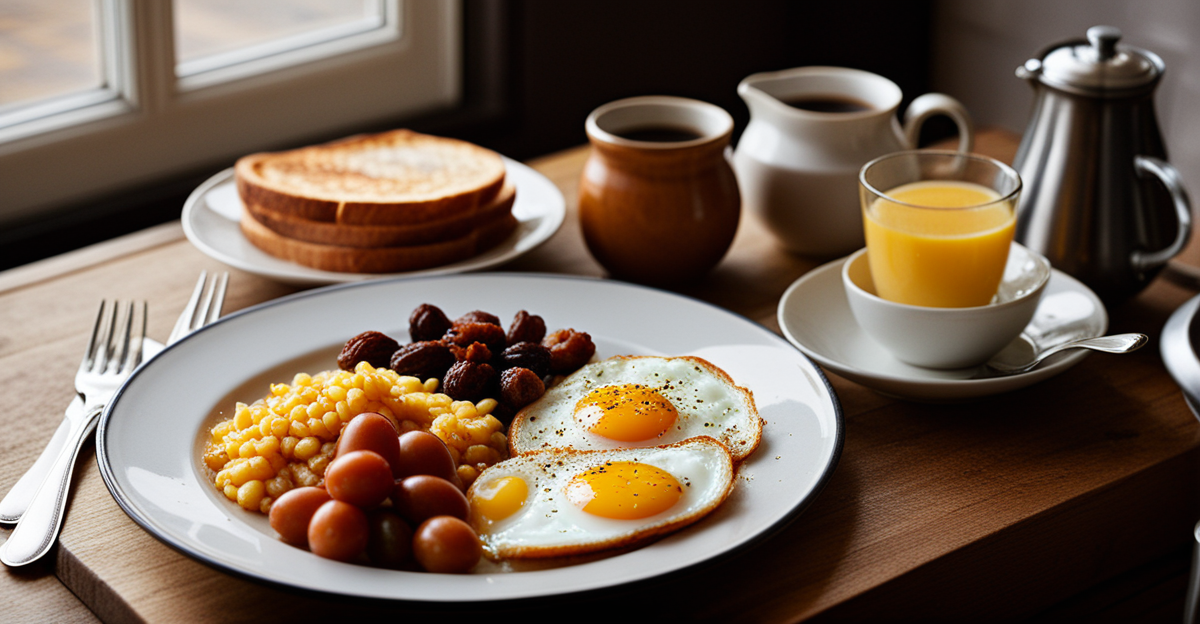Traditional English Breakfast Ingredients and Sourcing
Discovering the traditional English breakfast ingredients starts with the core essentials: eggs, bacon, sausage, baked beans, mushrooms, tomatoes, toast, and black pudding. These staples come together to form the iconic, hearty meal cherished across Britain.
Sourcing British ingredients locally can be straightforward by visiting butchers for quality sausages and bacon, artisan bakeries for freshly baked bread, and farmers’ markets offering organic mushrooms and tomatoes. Many cities also feature specialty shops that stock black pudding, a classic component often overlooked but vital for authenticity.
Have you seen this : What Are the Most Essential Tools for a British Home Cook?
If local options are limited, numerous online suppliers deliver genuine British products, ensuring you don’t compromise on quality. Opting for well-known English breakfast essentials brands guarantees that your dish maintains traditional flavors. Choosing carefully sourced ingredients elevates the breakfast experience, supporting local producers while delivering a meal that’s true to its roots.
Understanding the importance of authentic ingredients enhances your appreciation of the English breakfast and assures that each bite captures the distinctive character of this beloved morning feast.
Have you seen this : What tips can enhance your homemade scones for afternoon tea?
Step-by-Step Cooking Instructions for Each Component
To master how to cook English breakfast perfectly, follow precise English breakfast cooking instructions for each traditional ingredient. Start with the bacon and sausage. Fry the bacon in a moderately heated pan until crisp but not burnt, usually around 5–7 minutes, turning occasionally. For sausages, cook them thoroughly until browned and cooked through, about 12–15 minutes, turning regularly to ensure even cooking.
Next, the eggs—fried, scrambled, or poached—should be cooked gently to retain softness. Fried eggs take 2–3 minutes, scrambling requires low heat and constant stirring, and poaching demands fresh water simmering for 3–4 minutes. Baked beans are best warmed slowly on low heat to maintain texture.
Cook mushrooms by sautéing them in butter or oil until golden, roughly 5 minutes, and tomatoes by halving and grilling or frying until their skins just begin to wrinkle. Black pudding should be sliced and fried until crisp, about 3–4 minutes per side.
Coordination is key: stagger cooking so all components finish together, ensuring your English breakfast step-by-step experience is both efficient and delicious.
Tips for Preparing and Assembling the Breakfast Plate
Mastering the English breakfast serving guide begins with thoughtful English breakfast plate assembly. Aim to arrange each cooked element visibly and appealingly, highlighting the balance of colors and textures. Place eggs centrally to catch the eye, with sausages and bacon flanking them. Toast, baked beans, mushrooms, and tomatoes should be neatly sectioned to prevent sogginess and maintain their distinct flavors.
For genuine English breakfast presentation, use classic white ceramic plates to complement the warm tones of the food. Ensuring components like black pudding are sliced evenly and positioned prominently adds authenticity. Light garnishes such as a sprig of fresh parsley or a wedge of lemon for the mushrooms enhance visual appeal without overpowering flavors.
Consider the practicality of serving—hot plates help keep the meal warm, while small ramekins or bowls for baked beans avoid spillover and encourage tidy dining. This level of care in presentation transforms a simple meal into a memorable feast, fulfilling both the aesthetic and taste expectations of a classic English breakfast serving guide.
Variations and Dietary Modifications
Adapting the traditional English breakfast ingredients to suit dietary needs is both practical and delicious. For a vegetarian English breakfast, replace sausages and bacon with plant-based alternatives like vegetarian sausages or smoked tofu. Black pudding, which is not vegetarian-friendly, can be substituted with grilled halloumi or vegetarian black pudding varieties. Beans, mushrooms, tomatoes, eggs, and toast remain essential for a satisfying dish.
For vegan options, swap eggs with scrambled tofu or chickpea flour pancakes and buttered toast with oil-based spreads. Many brands now offer English breakfast essentials catering to vegan and gluten-free diets, such as gluten-free sausages and baked beans without added sugars or animal products.
Dietary substitutions in a classic English breakfast do not mean compromising on flavour or texture. Using authentic seasonings and cooking techniques ensures that alternatives remain true to the spirit of the dish. This approach allows everyone to enjoy an inclusive, hearty meal, demonstrating that sourcing British ingredients can be flexible without losing tradition. Such adaptability encourages exploring English breakfast variations for a modern, health-conscious breakfast experience.
Estimated Cooking Times and Helpful Preparation Tips
Understanding English breakfast cooking time is vital for a smooth kitchen experience. On average, frying bacon takes about 5–7 minutes, sausages require 12–15 minutes, and black pudding needs 3–4 minutes per side. Eggs vary: fried eggs cook in 2–3 minutes, scrambled eggs need gentle heat and constant stirring for about 5 minutes, while poached eggs take 3–4 minutes. Mushrooms and tomatoes each take roughly 5 minutes to sauté or grill, and baked beans should be warmed slowly on low heat to preserve texture and flavor.
To manage English breakfast meal planning, start by preparing slower-cooking items like sausages and bacon first. Use separate pans if possible to cook components simultaneously, making coordination easier. Keep toast warm by using the oven on low heat or a toaster just before serving. Consider batch prepping mushrooms or baking beans ahead and reheating gently.
Effective English breakfast preparation tips include organizing ingredients beforehand and monitoring heat carefully to avoid overcooking. This approach ensures all the English breakfast essentials come together hot and fresh, allowing you to serve the classic meal with ease and confidence.









